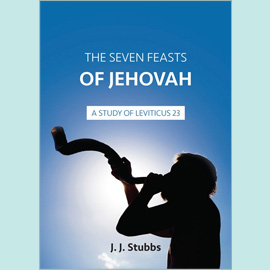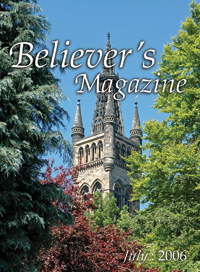Christ as Jehovah Ropheca
Mk 1.40-45 (Mt 8.1-4; cf Lk 5.12-15)
To identify the purpose and appreciate the profound significance of this miracle, we must understand the background against which it is performed. It was notable historically because this was the first known occasion of a Jew being cured of leprosy since the law of leprosy was given centuries earlier. It was morally significant in that leprosy was regarded as divine judgment against sin (Miriam and Uzziah, Num 12; 2 Chr 26.20-21). For this reason leprosy was referred to as "the finger of God", or "the stroke", and it had no remedy in Jewish medicine. The moral-dispensational significance is seen in that the leper’s uncleanness and separation represented the spiritual condition of God’s chosen people at that time. Of deepest significance is the theological context. Leprosy had no cure among men. If a person was cured of leprosy, it was a sign that God in sovereign grace and divine power had done the healing. This was acknowledged by the King of Israel when he was asked to cure the leprous Naaman: "And it came to pass, when the king of Israel had read the letter, that he rent his clothes, and said, Am I God, to kill and to make alive, that this man doth send unto me to recover a man of his leprosy?" (2 Kings 5.7).
The man kneeling before Christ was "full of leprosy", but his yielded heart barred any doubt that Christ could heal him. In an expression of pure faith, the helpless leper never propositioned Christ’s power but pleaded His divine prerogative - "if thou wilt, thou canst...". This Christ did by exercising His own divine will and through His own divine power (Mk 1.40-41). Matthew tells us the healed leper worshipped the Lord, worship that was accepted by Him for He was God.
Here, then, is the divine intent and deep significance of this miracle. It is a clear demonstration of the particular manner in which Christ revealed His deity before men, in that He declared it within the historical, prophetical and theological framework of the Old Testament. The Jewish leper was healed by Christ as a "testimony unto them" - the Jews - that He was Jehovah Ropheca, who had moved in divine power and prerogative; that He was Emmanuel, God with us, the divine Messiah who had come as prophesied to restore to God a separated and disobedient people.
This miracle reveals that Jesus of Nazareth possessed the marks of deity. He chose to do, and did, what only God could do, thereby manifesting His divine glory. Luke records the Lord healing another ten lepers. Each one is an emphatic revelation of His undiminished and unceasing deity, of His divine power, prerogative, and glory (Lk 17.11-19). But, like so many today, the Jews were blinded in their unbelief in regard to His divine Majesty.
The Miracles of Christ - manifestations of deity
Christ’s deity was pivotal to His earthly ministry concerning the kingdom of God, Israel, and the gospel of eternal life to all men. Many of His miracles therefore were performed to reveal and convict men that He was God - Emmanuel, God with us. Who but the Divine Physician could heal the "sick unto death" with a word or a touch? Only the word of the Divine Judge could cause the predacious mob to fall backwards, or cause the fig tree to wither and dry up from its roots. Only the Omnipotent Creator could still the wind and the waves. Who but divine Omniscience could see into the heart of a demoniac and free him from spiritual bondage? Who except the divine Life had the authority and power to Himself raise the dead?
Consider again the leper’s healing and how it typified the Lord’s miracles, revealing His possession and exercise of the attributes of God. The miracles performed by the prophets and apostles were done in the permissive will of God, through the power of God and in God’s name - even the name of Christ! The miraculous power involved was not inherent in these men. Peter makes this clear when he healed the lame man at the gate Beautiful. "Ye men of Israel, why marvel ye at this? or why look ye so earnestly on us, as though by our own power or holiness we had made this man to walk?" (Acts 3.12). If Peter claimed to have performed this miracle himself, he would be claiming to possess the attributes of God. He could not, of course, claim such a thing, but Christ did! His miracles were done in His own name, through His own power and according to His permissive will: "I will" (Mk 1.41); "I charge thee" (Mk 9.25); "I say unto thee, Arise" (Lk 7.14); "I will come and heal him" (Mt 8.7); "Believe ye that I am able to do this?" (Mt 9.28). Each authoritative utterance is a sacred witness to His possession of the divine attributes - the ability to do what only God can do; His divine prerogative - to do what only God can choose to do; His divine glory - the result of having done what only God could have done, revealing His undiminished and unceasing deity.
Christ as Saviour-God
Mk 2.1-12 (Lk 5.17-20)
Again the Lord seeks to reveal His messianic deity through a miracle performed within the theological context of the Old Testament. What the previous miracle gave in type, cleansing from sin, is now demonstrated in reality. Here it is not, "Who can cure leprosy save God only?" It is, "Who can forgive sins save God only?" (v.7; Ps 32.1-5; 51.1-2).
The Jewish religious leaders rightly believed that only God can forgive sins. It was God who held the nation accountable for sin, as seen in the Old Testament economy of sacrifices and offerings. David’s confession taught them that sin is against God even when transgressing against man - "Against thee, thee only, have I sinned, and done this evil in thy sight" (Ps 51.3-4; Lk 15.21; cf Jer 31.34). Sin is against God because God is man’s creator and He is absolutely holy. Christ is man’s creator and He also possesses the divine attribute of absolute holiness. Paul declares that sin is against Christ (1 Cor 8.12). The Jews knew from the Holy Oracles, that God has the exclusive authority to forgive sins because God is the only One who is absolutely holy. When therefore the Lord claimed authority to forgive this man’s sins, He was claiming to possess the attribute of divine holiness and to possess the associated divine prerogative to forgive sins. Little wonder the Jews considered His words blasphemous.
Yet, knowing why He was being accused of blasphemy, the Lord never withdrew or tempered His claim to possess the prerogative to forgive sins. Indeed, He proceeded to confirm His undiminished and unceasing deity by healing the man, His words also justifying His claim to it. Which authority is easier to claim, to say to the sick of the palsy, "Son, thy sins be forgiven thee", or to say, "Arise, and take up thy bed, and walk"? Both actions fall exclusively within the prerogative of God and call upon His divine attributes. By demonstrating the latter He proved His possession of the former.
There is a further revelation of Christ’s undiminished and unceasing deity here, in that He knew the thoughts and perceived the inner reasoning of the scribes. This is the preserve of Omniscient Deity, "for thou [Jehovah], even thou only, knowest the hearts of all the children of men" (1 Kings 8.39). The leper was healed "for a testimony unto them". Here the healing was done "that ye may know" (Mk 2.10). Know what? It was that the Son of Man had authority on earth to forgive sins and that He is God. This divine title is associated with divine universal authority (Dan 7). Here again it was Emmanuel, "God with us", but the conceit of the Jews blinded them to the reality of it. Extracted from "My Lord and my God".









